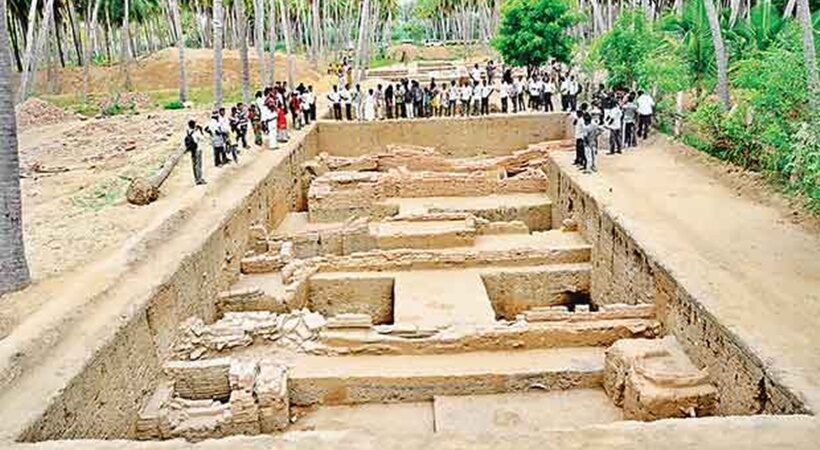History is an integral component for building an identity, as its ever-mutating perceptions influence contemporary narratives of power, identity, politics and legitimacy. The ongoing seven-phase excavations at a small village called Keezhadi in the Sivaganga district of Tamil Nadu is a recent example of this phenomenon. The excavations at the site have been mired in controversy and the urban settlement of ancient people has become a battlefield between Hindutva and Dravidian politics. The excavations began at Keezhadi when the Archaeological Survey of India began explorations in 293 sites along the Vaigai river valley in 2013-14. Keezhadi was chosen for further archaeological study and the excavations yielded multiple findings of advanced material culture and an urban settlement in an ancient civilization. Carbon dating of charcoal found at the site placed it to around 200 BCE, indicating the existence of an urban civilization since the Sangam age.

However, the abrupt and unexplained transfer of K. Amarnath Ramakrishna, Superintending Archaeologist overseeing the excavations in 2017 caused a political storm in Tamil Nadu. The reluctance of the Central Government to continue excavations by delaying the approval and the ASI’s insistence regarding no “significant findings” in the third phase was heavily criticized by various political parties, writers and film personalities in Tamil Nadu. The matter reached the high court and due to the intervention of the Madurai Bench of Madras High Court, ASI permitted the state department of archaeology to conduct excavations on their own. Since then, thousands of antiquities have emerged from the site, ranging from brick structures, iron implements, gold ornaments, stepwells, red and black ware and beads made of glass, terracotta and semi-precious stones. This is an exciting time for archaeologists as now the focus has been shifted from megalithic burials and Roman coin findings to megalithic habitation sites.
Out of these findings, experts have pushed forward several exciting theories that are being contested fiercely by opposing camps. The contestations arise out of concerns regarding the suggested dating of these antiquities and ideological formulations. However, the state department has already started setting updating labs and is pushing for collaborations with universities and specialized labs around the country and abroad to throw more light on the implications of these excavations. The seventh phase is still ongoing and is yielding more antiquities such as terracotta tablets with Tamil- Brahmi inscriptions and Silver punch-marked coins.
Here are some of the thrilling findings emerging from the excavations at Keezhadi:
Keezhadi is an urban and industrial settlement

Countering the previous understanding of urbanization in South India in the early centuries of the common era, the data emerging from Keezhadi points to urban life and settlements in the early historic period. This places the settlement of Keezhadi in parallel to the second urbanization happening in the Ganges valley. The existence of brick structures, domesticated animals, specialized tools and crafts and massive findings of material remains and the use of Tamil-Brahmi script all point to an urban settlement. The spectroscopic analysis of the black and red ware reveals that the artisans at Keezhadi were familiar with the technique of using carbon materials for black color and hematite for the red as well as developed kilns that could reach the temperature of 1100 °C.
Tamil-Brahmi script is older
Archaeologists have found a plethora of artifacts with inscriptions pointing to a highly literate society. Common objects such as pots were inscribed with possibly the name of the owners and other themes before applying the glaze. Each pot had a unique writing style, and more than 70 such pots have been found to date. Recently, carbon samples from the site were sent to the Beta Analytic Lab in Miami, Florida, for carbon dating which traces the material remains from the 6th century BCE to the 1st century BCE. Scientific dates obtained from the site is suggesting that the Tamil-Brahmi script is hundred years old and can be found in the 6th century BCE.
A possible connection with the Indus Valley Civilization
According to some scholars, one of the only remaining residual link between the Indus Valley Civilization and later developments in the subcontinent is the Iron Age remains found in South India. The graffiti marks found in such Iron age settlements purportedly contain similarities with the Indus Valley script. The findings of graffiti marks on potsherds in Keezhadi bear a close resemblance with Indus valley signs as well. Moreover, experts have pointed to a link between the urban planning of Indus valley cities and Keezhadi.

However, such claims have been heavily contested by historians and archaeologists and more substantial evidence is required to arrive at any conclusion.



















